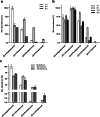An enzymatic tandem reaction to produce odor-active fatty aldehydes
- PMID: 36040487
- PMCID: PMC9468042
- DOI: 10.1007/s00253-022-12134-3
An enzymatic tandem reaction to produce odor-active fatty aldehydes
Abstract
Aldehydes represent a versatile and favored class of flavoring substances. A biocatalytic access to odor-active aldehydes was developed by conversion of fatty acids with two enzymes of the α-dioxygenase pathway. The recombinant enzymes α-dioxygenase (α-DOX) originating from Crocosphaera subtropica and fatty aldehyde dehydrogenase (FALDH) from Vibrio harveyi were heterologously expressed in E. coli, purified, and applied in a coupled (tandem) repetitive reaction. The concept was optimized in terms of number of reaction cycles and production yields. Up to five cycles and aldehyde yields of up to 26% were achieved. Afterward, the approach was applied to sea buckthorn pulp oil as raw material for the enzyme catalyzed production of flavoring/fragrance ingredients based on complex aldehyde mixtures. The most abundant fatty acids in sea buckthorn pulp oil, namely palmitic, palmitoleic, oleic, and linoleic acid, were used as substrates for further biotransformation experiments. Various aldehydes were identified, semi-quantified, and sensorially characterized by means of headspace-solid phase microextraction-gas chromatography-mass spectrometry-olfactometry (HS-SPME-GC-MS-O). Structural validation of unsaturated aldehydes in terms of double-bond positions was performed by multidimensional high-resolution mass spectrometry experiments of their Paternò-Büchi (PB) photoproducts. Retention indices and odor impressions of inter alia (Z,Z)-5,8-tetradecadienal (Z,Z)-6,9-pentadecadienal, (Z)-8-pentadecenal, (Z)-4-tridecenal, (Z)-6-pentadecenal, and (Z)-8-heptadecenal were determined for the first time. KEY POINTS: • Coupled reaction of Csα-DOX and VhFALDH yields chain-shortened fatty aldehydes. • Odors of several Z-unsaturated fatty aldehydes are described for the first time. • Potential for industrial production of aldehyde-based odorants from natural sources.
Keywords: Biotransformation; Fatty aldehyde dehydrogenase (FALDH); Fatty aldehydes; Flavoring production; α-Dioxygenase (α-DOX).
© 2022. The Author(s).
Conflict of interest statement
Authors declare no competing interests.
Figures




Similar articles
-
Biocatalytic Production of Odor-Active Fatty Aldehydes from Fungal Lipids.J Agric Food Chem. 2023 May 31;71(21):8112-8120. doi: 10.1021/acs.jafc.3c01972. Epub 2023 May 17. J Agric Food Chem. 2023. PMID: 37196237
-
Biotechnological Production of Odor-Active Methyl-Branched Aldehydes by a Novel α-Dioxygenase from Crocosphaera subtropica.J Agric Food Chem. 2020 Sep 23;68(38):10432-10440. doi: 10.1021/acs.jafc.0c02035. Epub 2020 May 26. J Agric Food Chem. 2020. PMID: 32396373
-
Oxidation of fatty aldehydes to fatty acids by Escherichia coli cells expressing the Vibrio harveyi fatty aldehyde dehydrogenase (FALDH).World J Microbiol Biotechnol. 2013 Mar;29(3):569-75. doi: 10.1007/s11274-012-1211-2. Epub 2012 Nov 21. World J Microbiol Biotechnol. 2013. PMID: 23180547
-
α-Dioxygenases (α-DOXs): Promising Biocatalysts for the Environmentally Friendly Production of Aroma Compounds.Chembiochem. 2022 Jun 20;23(12):e202100693. doi: 10.1002/cbic.202100693. Epub 2022 Feb 15. Chembiochem. 2022. PMID: 35107200 Free PMC article. Review.
-
Mass spectrometry of fatty aldehydes.Biochim Biophys Acta. 2011 Nov;1811(11):680-93. doi: 10.1016/j.bbalip.2011.08.018. Epub 2011 Sep 9. Biochim Biophys Acta. 2011. PMID: 21930240 Free PMC article. Review.
Cited by
-
A Sequence Motif Enables Widespread Use of Non-Canonical Redox Cofactors in Natural Enzymes.bioRxiv [Preprint]. 2025 Aug 2:2025.08.01.668186. doi: 10.1101/2025.08.01.668186. bioRxiv. 2025. PMID: 40766508 Free PMC article. Preprint.
-
Enzymatic reactions towards aldehydes: An overview.Flavour Fragr J. 2023 Jul;38(4):221-242. doi: 10.1002/ffj.3739. Epub 2023 Apr 10. Flavour Fragr J. 2023. PMID: 38505272 Free PMC article. Review.
References
-
- Akakabe Y, Matsui K, Kajiwara T. Enantioselective α-hydroperoxylation of long-chain fatty acids with crude enzyme of marine green alga Ulva pertusa. Tetrahedron Lett. 1999;40(6):1137–1140.
-
- Becher PG, Lebreton S, Wallin EA, Hedenström E, Borrero F, Bengtsson M, Jörger V, Witzgall P. The scent of the fly. J Chem Ecol. 2018;44:431–435. - PubMed
-
- Berger RG. Aroma Biotechnology. Berlin-Heidelberg: Springer; 1995.
-
- Birk F, Fraatz MA, Esch P, Heiles S, Pelzer R, Zorn H. Industrial riboflavin fermentation broths represent a diverse source of natural saturated and unsaturated lactones. J Agric Food Chem. 2019;67(49):13460–13469. - PubMed
MeSH terms
Substances
Grants and funding
LinkOut - more resources
Full Text Sources
Miscellaneous

